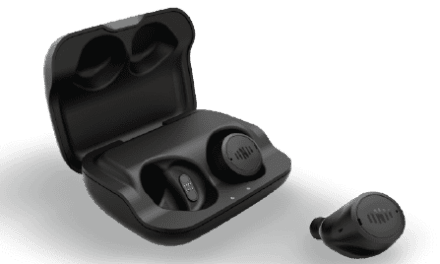SPECIAL SECTION: OTC HEARING AIDS
New technologies that are improving communication for people with hearing loss
Active noise cancellation and LE Audio are examples of two important technical innovations that may help transform OTC hearing aids, allowing for improved own-voice perception and more numerous streaming options for consumers, respectively. Other enhancements like inertial and biometric sensors also show promise for widening the market for amplication devices.
By Andrew Sabin, PhD
As its name suggests, the most novel part of the 2017 Over-the-Counter Hearing Aid Act is that it allows manufacturers to sell their aids directly to consumers. Accordingly, substantial invention is expected relative to the digital delivery of hearing aid services that have been traditionally delivered by hearing care professionals (HCPs). Examples include self-fitting of electroacoustic parameters, remote programming and assistance with physical fitting, and auditory counseling. While we have reported on these challenges in the past1 and this edition of The Hearing Review also addresses several of them, the present article focuses on two new technologies that might be especially valuable to customers of OTC devices.
Two Important Design Improvements for OTC Hearing Aids
It is reasonable to assume that, compared to traditional hearing aid customers, OTC customers will have less-severe loss and will more actively use mobile devices. The Act says that the new category is intended to serve individuals with perceived mild-to-moderate hearing loss. Since hearing loss severity tends to increase with age, OTC customers will likely be younger—which often means more mobile devices usage. Additionally, OTC hearing aids could be unappealing to tech-phobic users because these products will likely rely on user-initiated digital interfaces.
Design challenges for people with milder hearing losses. If OTC customers truly have less hearing loss and use mobile devices more, then high-quality audio streaming could be especially important to them. Hearing aid design constraints have typically not been compatible with high quality streaming.
In particular, the bandwidth of music playback is one of the most important factors contributing to sound quality. In normal-hearing listeners, a reduction in bandwidth due either to lowering the high-frequency cutoff or raising the low-frequency cutoff leads to monotonic decreases in reported music sound quality.2 Unfortunately, the bandwidth of most hearing aids is much poorer than most consumer electronics earbuds both at their low- and high-frequency ends.
On the low-frequency side, the most important factor is the coupling to the ear. As venting increases, low-frequency sound pressure leaks out to a greater extent. This relationship was recently characterized by Balling et al3 who showed that, on average, an open-fit dome reduces output by about -10 dB per octave starting around 2 kHz. At 125 Hz, this equates to 40 dB reduction compared to a sealed system. Accordingly, earbuds in consumer electronics are usually more sealed, and many use moving coil transducers (instead of balanced armature) because of their increased diaphragm displacement. As a result, these earbuds can often provide even more than 40 dB more output at low frequencies than an open-fit hearing aid.
Active occlusion cancellation (AOC). Of course, a principal appeal of open-fit coupling is that it reduces (or eliminates) the occlusion effect by letting the low-frequency body-conducted sound exit the ear canal, while still allowing sufficient high-frequency gain. Indeed, a “boomy” self-voice is one of the top complaints from new hearing aid users.4 Taken together, open vs sealed coupling has historically been treated as a design tradeoff made by manufacturers and clinicians. The great popularity of open-fit devices in the current market indicates that traditional hearing aid customers are willing to compromise low-frequency output and streaming sound quality in order to reduce the occlusion effect.
Active occlusion cancellation (AOC) can fundamentally alter that tradeoff by providing an alternative means of reducing the occlusion effect. AOC works on the same principle as acoustic noise cancellation (ANC) used in several consumer headphones/earbuds: It delivers a sound that is approximately equal in magnitude but opposite in phase to that of a target sound. This results in “destructive interference” and partial cancellation of that target—in this case, the body-conducted self-voice trapped in the ear canal. The result is that people can wear a sealed coupling for superior sound quality while minimizing the occlusion effect. This technology is implemented in Bose Hearphones (Figure 1) which seals the ear canal for high quality streaming but reduces occlusion via AOC. Occlusion reduction with the current AOC systems is not perfect, but substantial improvements may be possible.

Low Energy (LE) Audio. While the low-frequency streaming performance of hearing aids is primarily limited by ear coupling, the high frequency performance is limited by wireless audio codecs. The protocol currently used for high-quality music streaming in Bluetooth headphones (A2DP/SBC at sampling rate 44.1 or 48 kHz) consumes substantial power and, therefore, has been largely incompatible with the runtime requirements of hearing aids. In response, proprietary solutions that consume less power have been developed (eg, Apple’s MFi hearing aid streaming and Android’s ASHA streaming). The power reduction relies, in large part, on a reduced sampling rate. In many cases, the sampling rate is 12 kHz, implying a maximum high-frequency audio cutoff of 6 kHz. This might be acceptable for individuals who have little residual hearing at >6 kHz; however, OTC customers are likely to have some hearing at those frequencies and will therefore notice degraded sound quality.
Low Energy Audio (LE Audio), recently announced as part of the Bluetooth 5.2 specification,5 provides a solution to this problem.This new standard will enable high quality audio to be streamed at lower bitrates (and therefore lower power consumption). LE Audio relies on a new codec (Low Complexity Communications Code or “LC3”) that delivers similar sound quality to A2DP but at roughly half of the bitrate. LE Audio also utilizes new radio protocols that decrease the required airtime which further decreases power.
In addition to better audio quality, LE Audio also provides an opportunity for new experiences for hearing aid customers who use mobile devices.6 A new feature called “Broadcast Audio” will allow streaming from one transmitting device to many listening devices. This feature could be used in performance and lecture halls instead of telecoil or FM systems, potentially replacing them over time. There are new possibilities such as translating multiple languages at once. Another feature called “Audio Sharing” will allow users to subscribe to streams either from a friend’s device (eg, watching a movie on their phone) or from a location of interest (eg, notifications from your airport). LE Audio will likely be supported by all major mobile device manufacturers.
Inertial and Biometric Sensors to Assist People with Hearing Loss—and Possibly Help Grow the Market
Collectively these two technologies will enable high-quality audio streaming. AOC will indirectly enable more low-frequency output by allowing sealed ear coupling with reduced occlusion. LE Audio will enable an extended high-frequency cutoff by allowing higher audio sampling rates together with lower bitrate encoding. Collectively, wider bandwidth audio will make the multitude of applications that rely on streamed audio more enjoyable and potentially more appealing to customers of OTC hearing aids.
Finally, it is also possible that OTC customers will value additional features that are not directly tied to audio. An extraordinarily wide range of sensors have been explored. Perhaps the most common category of non-audio in-ear sensors are inertial measurement units (eg, accelerometers/gyroscopes) which are beginning to be employed in some hearing aids. These units enable features like step counting, fall detection, novel UIs, and augmented reality experiences.
Another common category is biometric sensors that are used for monitoring vital signs like heart rate and blood pressure. Despite the enthusiasm around these in-ear features, none have yet gained mass acceptance in the marketplace to date. That said, this area will undoubtedly expand as the OTC category takes shape and the market sorts out which features users value.

Framingham, Mass.
Correspondence can be addressed to Dr Sabin at: [email protected].
Citation for this article: Sabin A. Tech trends in OTC hearing aids. Hearing Review. 2020;27(6):18-19.
References
1. Sabin AT, Van Tasell DJ, Rabinowitz B, Dhar S. Validation of a self-fitting method for over-the-counter hearing aids. Trends Hearing. 2020;24:1-19.
2. Moore BCJ, Tan C-T. Perceived naturalness of spectrally distorted speech and music. J Acoust Soc Am. 2003;114(1):408.
3. Balling LW, Jensen NS, Caporali S, Cubick J, Switalski W. Challenges of instant-fit ear tips: What happens at the eardrum? Hearing Review. 2019;26(12):12-15.
4. Jenstad LM, Van Tasell DJ, Ewert C. Hearing aid troubleshooting based on patients’ descriptions. J Am Acad Audiol. 2003;14(7):347-360.
5. Woolley M. Bluetooth. Bluetooth Core Specification Version 5.2 Feature Overview. https://www.bluetooth.com/wp-content/uploads/2020/01/Bluetooth_5.2_Feature_Overview.pdf. Published January 6, 2020.
6. Hearing instrument manufacturers: ‘Bluetooth LE Audio is a major step ahead for hearing aid users.’ Hearing Review. https://hearingreview.com/hearing-products/accessories/assistive-technologies/bluetooth-le-audio. Published January 7, 2020.
Other Articles in the OTC Hearing Aids Special Section series below:
Understanding Hearing Aid Rejection and Opportunities for OTC Using the COM-B Model
Meeting the Challenges of OTC: Who Are Self-fitting Hearing Aids Really For?
Individualizing Hearing Healthcare: New Opportunities in OTC Hearing Aids




